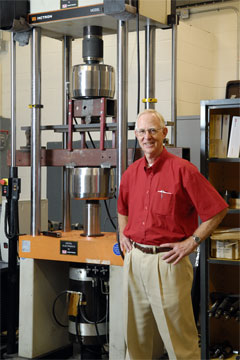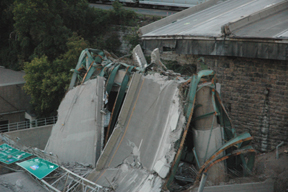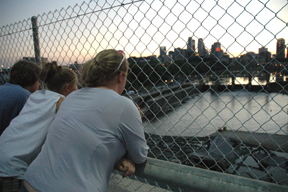Esteemed Researchers Keeping Bridges Safe

The University of Kansas Fatigue and Fracture Research Group was extending the lives of steel bridges long before the shocking Aug. 1 collapse of the Minneapolis Interstate 35W Mississippi Bridge.
But in the wake of that deadly disaster, KU's four-decades-long mission to make bridges safer has added urgency.
"We still don't know what happened in Minneapolis," said Stanley T. Rolfe, the Albert P. Learned Distinguished Professor of Civil, Environmental and Architectural Engineering, who leads the group. "It took everyone by surprise. It's a wake up call that we need to spend more time, effort and money on maintenance of older bridges."
A recipient of the American Society for Testing Materials Fracture Mechanics Medal, Rolfe brings more than 40 years of research and national leadership to the subject of bridge integrity. He also has co-authored a classic textbook, "Fatigue and Fracture Control in Structures," now in its third printing.
Rolfe heads a team of engineering faculty at KU composed of professors Ron Barrett-Gonzalez, Caroline Bennett and Adolfo Matamoros, who work with outside engineers at agencies and firms such as the Kansas Department of Transportation and Kansas City, Mo.-based architectural and engineering firm HNTB Corp. Using computer simulations, field instrumentation, lab tests and analysis of high-performance materials, the group's cutting-edge research drives toward improved understanding of steel bridges' resistance and reaction to fatigue and fracture.

"There's an excellent relationship between the teaching, the research and the professional service nationally," said Rolfe. "We can help the profession implement better design rules and better control, so that we don't have fracture or fatigue failures in our bridge structures."
The Fatigue and Fracture Research Group also has saved the taxpayers of Kansas millions of dollars. Working with KDOT, the KU group has helped to safely extended the viability of older bridges that otherwise would be replaced with new multimillion-dollar spans. The latest example is the Tuttle Creek Bridge on K-16 near Manhattan. After the 5,350-foot-long steel structure developed fatigue cracks, the group analyzed the bridge and suggested repair methods and retrofits. To date, the bridge has not developed new cracks and is estimated to have 100 more years of useful life.
"You talk about getting big benefits from research," said Kenneth Hurst, engineering manager of the State Bridge Office at KDOT. "We've been working with KU and Stan Rolfe for quite some time on fracture and fatigue issues. The Tuttle Creek Bridge was sort of a culmination where we verified the retrofitting on KU's computers and validated it in the field by actually doing the testing. We're very proud of this particular job."

Indeed, the entire bridge inventory of KDOT benefits from the KU group's testing and retrofitting expertise. But bridges across the nation also are in need of such attention. The American Society of Civil Engineers reports that more than 75,422 bridges across the United States are structurally deficient and require a $188 billion investment in repairs over the next two decades.
"Our research can be applied nationally," said Rolfe. "(President) Eisenhower started the Interstate program in the '50s, and most bridges were built in the '60s. They're old and it's just normal that with wear, corrosion and age, structures become deficient. They're not going to behave the same way they did when they were built."
With funding from KU's Transportation Research Institute and KDOT, the Fatigue and Fracture Research Group now is investigating use of composite materials in steel bridge girders. The group has shown that carbon fiber can stiffen fatigue-prone regions of bridges. They also are improving methods for detecting fatigue problems well before they worsen and possibly become catastrophic.
However, the group's leader emphasizes that bridge collapses are far from commonplace.
"By and large, our structures are quite safe," said Rolfe. "I don't think there needs to be a concern about the public driving over them. But does there need to be a concern about maintenance and repair? Yes."